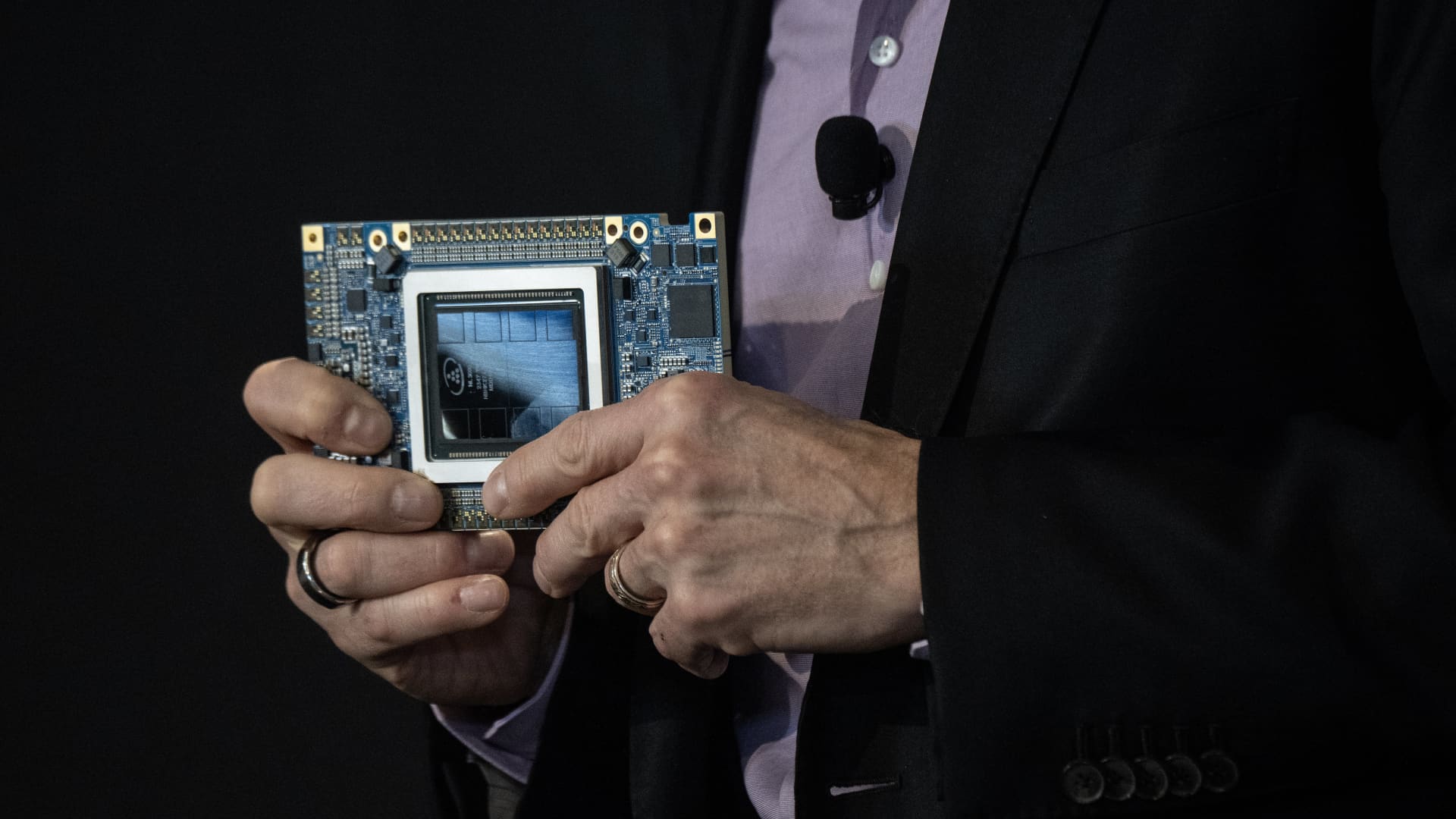Pat Gelsinger, CEO Intel, speaking on CNBC’s Squawk Box at the WEF Annual Meeting in Davos, Switzerland on Jan. 16th, 2024.
Adam Galici | CNBC
Intel shares dropped in extended trading on Thursday after the chipmaker issued an outlook for the first quarter of 2024 that lagged analyst forecasts even as results for the latest quarter beat Wall Street estimates.
Here’s how Intel did versus LSEG (formerly Refinitiv) consensus expectations for the quarter ended in December:
- Earnings per share: 54 cents adjusted, vs. 45 cents expected
- Revenue: $15.4 billion vs. $15.15 billion expected
For the first quarter of fiscal 2024, Intel expects earnings per share of 13 cents on between $12.2 billion and $13.2 billion in sales, versus LSEG expectations of 33 cents per share on $14.15 billion of revenue.
Intel CEO Pat Gelsinger said on a call with analysts that the core businesses — PC and server chips — would be at the low end of the the company’s seasonal range in the current quarter, but that overall sales would take a hit because of weakness in subsidiaries including Mobileye and its programmable chip unit, as well as revenue decreases from other businesses the company has spun off or sold.
“The core business we see as healthy,” Gelsinger said. “We see no areas for market share loss and the products are getting stronger.”
Intel posted net income of $2.7 billion, or 63 cents per share, compared to a net loss of $0.7 billion, or 16 cents per share, last year.
With Intel reporting sales growth in the fourth quarter of 10% from $14.04 billion a year earlier, the company breaks a streak of seven quarters with declining revenue. Intel’s gross margin was 40%, down 2.6 percentage points annually.
Intel shares are up over 74% over the past year. The company is the largest semiconductor maker by revenue, according to Gartner, a market research firm, even though its market cap puts it below Nvidia and AMD on Wall Street.
Cloud providers and large tech companies, the big spenders, have been focused on the AI boom, which explains Nvidia’s recent outperformance. In the past, the most important part in a server was the central processor made by Intel. Now, AI servers can have as many as eight Nvidia or AMD graphics processing units (GPUs) attached to one or two Intel CPUs.
“The data center has seen some wallet share shift between CPU and accelerators over the last several quarters,” said Intel CFO David Zinsner on a call with analysts on Thursday.
Intel also continues to focus on a five-year plan implemented by Gelsinger, who took over the chipmaker in 2021. Intel wants to catch up to Taiwan Semiconductor Manufacturing Company in its ability to offer manufacturing services to other companies, while also improving its own branded chips.
“The quarter capped a year of tremendous progress on Intel’s transformation,” Gelsinger said in a statement. Intel said on Thursday that it would restate past results under a new system where Intel has to account for costs related to internal manufacturing of its own chips.
Intel Foundry Services, its business making chips for other companies, remains nascent, with $291 million in revenue, a 63% annual increase.
Intel has been cutting costs through workforce reductions and offloading small parts of its business. In the past year, the company said it would spin off its programmable chip unit, after turning self-driving car subsidiary Mobileye into an independent company in 2022. Zinsner said that Intel had cut $3 billion in costs last year and the company spun off or sold five different business lines.
Intel’s largest division is its Client Computing group, which includes laptop and PC processor chips. The overall PC industry has been in a slump for two years, but recently started showing signs of growth again. Intel reported $8.8 billion in fourth-quarter sales, up 33%.
Gelsinger said that demand for PC chips had “normalized,” and that sales were strong in the gaming and commercial sectors. He added that Intel expects the total PC market to expand this year.
Intel’s second-biggest division, Data Center and AI, saw sales decline 10% to $4 billion. That unit includes server CPUs and GPUs. Intel’s Network and Edge department, which sells parts for carriers and networking, reported $1.5 billion in sales, down 24% from last year.
Zinsner said that Intel expected its Data Center business to decline “double-digit” percentages sequentially in the first quarter versus the fourth quarter.
Intel said it paid $3.1 billion in dividends in 2023.


